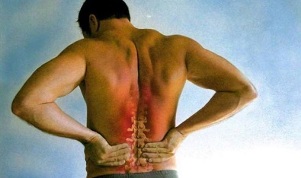
Back or low back pain is the most common complaint of patients in general medical practice. They are in second place (after respiratory illnesses) in terms of the frequency of requests for medical care. Many diseases lead to pain. But the most common cause is osteochondrosis of the lumbar spine, the symptoms and treatment of which are considered in this material.
Relatively recently, medicine has considered this condition to be age-related changes in the spine that have been associated with the natural aging processes of the human body.
Today, lumbar osteochondrosis is considered a fairly serious disease that occurs in all ages. Currently, the incidence shows a constant trend of rejuvenation, the disease is increasingly diagnosed in people under 30 years of age.
Causes of Occurrence
The cause of lumbar osteochondrosis has not been established. But when faced with this pathology, it is often assumed that who is more prone to the disease is at risk.
Predisposing factors:
- Passive lifestyle. Also included are people who have a predominantly sedentary lifestyle. In a sitting position, the muscles of the corset relax, which increases the load on the lumbar spine.
- Hormonal metabolic disorders and endocrine disorders can adversely affect metabolism in spinal tissues and contribute to the development of osteochondrosis.
- Various congenital and acquired disorders of the musculoskeletal system - curvature of the legs and spine, flat legs.
- There is constant heavy physical effort on the spine, especially when lifting heavy objects. In this case, we can talk about a category of occupational disease such as weightlifters and people whose professional job involves constantly lifting heavy objects.
- Constant unhealthy diet and daily routine, regular stress, insufficient sleep time, metabolic disorders.
The points listed above are the most common factors that create the preconditions for the development of the disease.
Degree of lumbar osteochondrosis
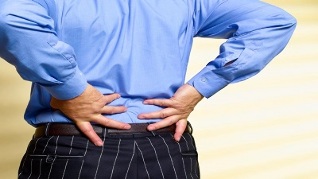
Manifestations of the disease depend on the degree of development of the pathology.
There are four stages of osteochondrosis:
- The pulposus is a period of change and movement within the disk itself. Pain occurs due to irritation of nerve endings in the annulus fibrosus and longitudinal ligaments. The patient feels local discomfort in the part of the spine where the affected plate is located: acute pain or lumbago in the lower back (lumbago), persistent dull pain (lumbodynia).
- Period of destruction of the annulus fibrosus. It is characterized by the appearance of instability and increased mobility of the vertebrae, which causes prolonged and lasting muscle tension. The patient feels symptoms such as constant tiredness of the lower back muscles, discomfort,
- The period of rupture of the annulus fibrosus and the exit of the nucleus pulposus beyond its boundaries with the formation of the herniated disc. So-called radical syndromes are observed, which are associated with the compression of nerve roots by fallen fragments.
- The spine is severely deformed. Human motor function is difficult. The main issue to be addressed is the disability of the patient. It should be emphasized, however, that there is virtually no pain at this stage of the disease. But this is not a signal to stop the disease, on the contrary.
- Bone tissue multiplies abnormally, which further worsens the condition.
Treatment of osteochondrosis of the lumbar spine depends directly on the extent of the lesion, using pharmacological, non-pharmacological, and surgical exposure methods.
Symptoms of lumbar spine osteochondrosis
When osteochondrosis of the lumbar spine occurs, the main symptom is pain. The nature of the pain sensations, the place of origin and the direction of spread depend on which receptors are irritated, ie how coarse the changes in the disc and surrounding tissues are, whether there is a protruding or already herniated, in which direction the protrusion developed, and so on.
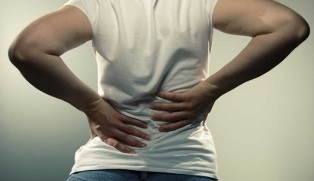
List the main symptoms of lumbar osteochondrosis:
- Pain in the lumbar spine, painful in nature, aggravated by sudden movement, change in body position, prolonged stay in one position. Pain relief occurs when placed in a horizontal position;
- In addition to lumbar spine pain, osteochondrosis can give a feeling of weakness in the lower torso and legs, as well as loss of tendon reflexes in the lower extremities;
- Lumbar spine curvature is common. Depending on the location of the curvature observed, a distinction is made between scoliosis (curvature of the spine to the right or left), lordosis (forward leaning), and kyphost (smoothing of the lumbar bend);
- If osteochondrosis has resulted in spinal cord compression and dysfunction, the patient may have uncontrollable urine and feces.
Additional features:
- skin coldness and numbness in the lumbar region, buttocks;
- dryness, peeling, blue skin on the lower back and buttocks;
- violation of sweating in the buttocks;
- urinary disorder;
- erectile dysfunction.
These symptoms indicate the development of the disease and require medical intervention. Treatment of osteochondrosis can be done in a hospital or at home.
Diagnostics
Diagnosis of osteochondrosis involves a variety of methods, primarily palpation of the lumbar spine.
To confirm the diagnosis, the patient is sent for examination using diagnostic tools:
- Radiography helps to assess the condition of the spine and each vertebrae separately. The integrity of the intervertebral discs and the spinal canal is also judged indirectly.
- The extent of nerve endings and damage to the lining of the spinal cord is determined by tomography. And also evaluate the condition of the intervertebral discs.
- MRI - to establish a definitive diagnosis.
A correct diagnosis will help you understand how to treat lumbar osteochondrosis and what medications and procedures will be needed to do so.
Complications
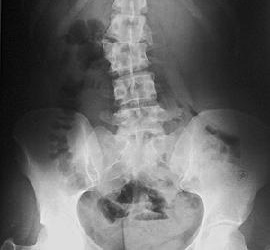
Protrusions and injuries of osteochondrosis of the lumbar spine can be due to significant loads on the spine. These complications develop very quickly, so it is very important to treat them in a timely manner.
In addition, osteochondrosis can be complicated:
- sciatic inflammation;
- spondyloarthrosis;
- Schmorl hernia;
- osteophytosis, spondylosis; narrowing of the spinal canal
- with compression and dysfunction of the spinal cord; compression of the cauda equina with pelvic organ dysfunction;
- lame;
- is a paresis of the lower extremities.
Timely diagnosis and complex treatment can prevent the progression of complications.
Treatment of lumbar spine osteochondrosis
When diagnosing lumbar osteochondrosis, treatment requires extensive complex therapy, which includes:
- moderate physical activity;
- use of drugs; the
- feature of the spine;
- manual therapy;
- physiotherapy;
- massage.
The osteochondrosis treatment regimen focuses on:
- termination of the inflammatory process;
- pain relief in the lumbosacral region;
- strengthening muscles in the lumbar region, buttocks, legs;
- elimination of pathological muscle tension;
- improving the functioning of pelvic organs;
- regulation of blood circulation and metabolic processes in the affected area;
- Restoration of normal range of motion in the lower back and increased sensitivity of the lower limbs.
Surgery is used in only a few cases.
Medication
Such treatment of osteochondrosis of the lumbar spine includes taking tablets, injections and external medications (ointments and gels). Medicines used to fight the disease relieve pain and stop inflammation.
Depending on the manifestations, your doctor may prescribe different pills for low back osteochondrosis:
- analgesics (painkillers);
- non-steroidal anti-inflammatory drugs;
- muscle relaxants to relieve muscle cramps due to pain;
- chondroprotectors that restore cartilage tissue;
- corticosteroids (prescribed if all other treatments have failed);
- vitamin preparations.
Very often, in the treatment of osteochondrosis, pills are prescribed that soothe the nervous system, as well as antidepressants that fight stressful situations and depression.
Physiotherapy for lumbar osteochondrosis
As a general rule, medications alone are not sufficient to treat osteochondrosis. Physiotherapy procedures are used to relieve pain, relieve muscle cramps, and stimulate metabolism and healing processes:
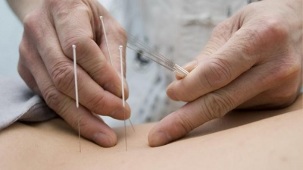
- amplipulse;
- phonophoresis;
- diadynamic currents;
- darsonvalization;
- magnetic resonance therapy;
- laser therapy.
Massage is prescribed when the main pain symptom disappears or in chronic pathology during remission. It is used to relax tense muscles. Very often combined with warm-up procedures or a visit to the sauna. This helps increase the relaxing effect of muscle tissue and stimulates blood circulation.
Manual therapy, performed only by a specialist in this field, increases the blood circulation in the spinal cord, replacing the displaced discs of the spinal column.
Physiotherapy
The full range of physical exercises used to diagnose lumbar osteochondrosis should help increase lumbar spine mobility.
Physiotherapy will not be effective if the exercises are done from time to time. The main principle of movement therapy is regularity. Continuous implementation of a certain set of exercises will help eliminate destructive processes in the intervertebral joints.
Surgery
Generally, your doctor will only prescribe surgery if you have major surgeries. For example, an intervertebral hernia. The most common type of surgery is removal of a damaged disc (discectomy).
This operation is considered to be the most productive method in this case, however, it is only prescribed if other treatment methods do not work within six months. In addition, microsurgical and endoscopic treatment of the spine is widespread.

























